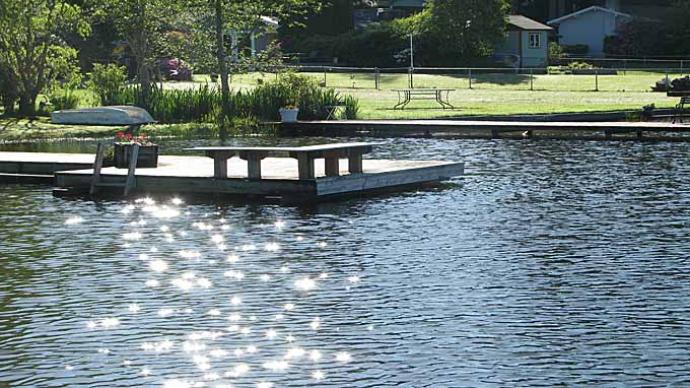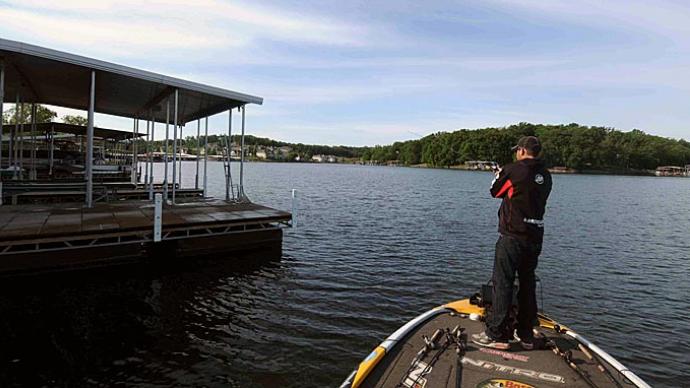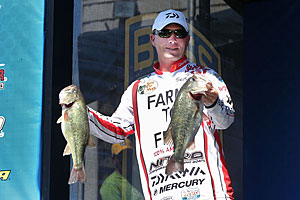
It has been more than ten years since Oklahoma bass pro Edwin Evers won the Bassmaster Tour event on Lake Norman. He spent most of the tournament fishing docks, catching 46 pounds and 6 ounces of bass over four days. That’s not unusual on the largest lake entirely within North Carolina. Most of it is lined with docks and boathouses of all shapes and sizes. In fact, near the launch of this tournament, there is one that accommodates a helicopter. It’s what he said next that needs to be remembered.
Edwin focused on the section of each dock that was closest to shore. He would make a few casts to the deeper end, but he caught most of his bass from the shallow end. That’s 180 degrees from the way most anglers fish docks. They start on the deeper end, pitching bottom-bouncing lures to pilings, around, and sometimes under moored boats. Often the pilings closest to shore go unfished, written off as too shallow to hold bass. As Evers showed, sometimes it pays to buck conventional wisdom.
It’s all in the approach
Bassmaster Elite Series Angler Andy Montgomery lives in Blacksburg, S.C., about 50 miles from Lake Norman. He knows this lake well. The two-time Bassmaster Classic qualifier won the 2014 Bassmaster Southern Open, and docks were vital to his victory. His success at Norman and experience at Lake Wylie, another dock-ringed reservoir just downstream on the Catawba River, have earned him the reputation as the top dock angler on tour.
Every dock is different, Montgomery said. Some are expansive, offering lots of overhead cover, while others are a sliver of planks with only enough structure to moor a small boat. A dock’s size and how it is situated dictates how to approach it. He said you must put yourself at the best angle for the best cast. For him, those are made under the dock, where there is the most shade. Bass find comfort and protection there, along with an advantage over baitfish.
Stay as far from the dock as you can comfortably cast. The farther away you are, the less likely you are to spook bass that are living there. “It’s just practice to make the right cast,” Montgomery said. And with more practice, you’ll be able to cast from farther away.
The most accessible dock spots to fish — typically the outside posts — are fished the most. Bass become conditioned and wary of what they see there. A lure falling where they haven’t seen one, such as a dark corner well under a platform, can inspire bass to bite. Skipping is the best way to put your lure in those tight spots.
Montgomery mostly skips a jig and trailer around docks. Its compact size and heavy weight make it a perfect candidate for skipping docks. He uses a 7-foot rod. Longer rods, with their extra casting distance and hook-setting power, are a benefit in many situations, but this isn’t one of them.
You’ll be more accurate and consistent with a shorter rod. It’s easier to keep its tip toward the water and generate faster casting speeds. Both are key to successfully skipping lures, just as your arm skipping stones. Casting rods, which handle big bass, lines, and lures best, are preferred for skipping. This setup requires an educated thumb to reduce backlashes. To avoid that problem altogether, skip your lures with a spinning rod. Spinning rods rigged with a tube or stick worm have pulled its fair share of Northern largemouth from under docks.
Spotting hidden places around docks take practice, too. Look for cobwebs around the underside of platforms, pilings, and moored boats. They indicate those spots haven’t been fished lately. And don’t bypass the sides of a dock. True, only one side at a time will be shaded, but aggressive bass will charge out to grab a lure that is worked down the side. If it is a floating dock, make sure your lure runs deeper than the floats, so a bass under the dock will see it.
Bottom-bouncing lures, such as Texas-rigged or shakey-head worms, jigs, and stick worms, are also perfect for skipping under docks. But in summer, especially on Southern impoundments devoid of grass, there is one more lure that you need to add to your dock-fishing arsenal.
Try something different
At certain times of the year and in certain parts of the country, anglers land big catches by making atypical lure choices when fishing docks. During the frigid 2015 Bassmaster Classic on Lake Hartwell in South Carolina, many competitors caught kicker-sized bass by slow-rolling swim baits around docks. In deep, clear Ozark lakes, jigging spoons are flipped to catch bass suspended below floating docks anchored over deep water. And on the reservoirs of the North and South Carolina Piedmont, anglers fish topwater lures around docks during the dog days of summer.
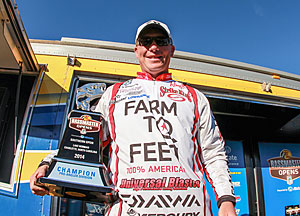
Around the new and full moons of June, July, and August, bream head to the banks to spawn. When they aren’t spawning, they hide under shallow cover, primarily docks, waiting to spawn again. Bass head to the docks to feed on them. “[Docks] can play a pretty big role,” Montgomery said of his summertime fishing.
The best summertime docks are at the mouth of coves. Montgomery said that bream prefer to spawn where they’re safe from the current. The type of dock doesn’t matter. “It’s more about shade,” he said. As you float close to a dock, you will see bream swimming under it, often between the floats or around a post, just a fraction of an inch under the surface. The lack of aquatic grass makes this summer dock pattern so strong. In Northern lakes, bass, and the panfish they eat also find shade in the abundant aquatic grasses, which spreads them out.
While Montgomery will swim a bream-colored jig around a dock, he’ll more often reach for a 6-foot, 6-inch rod rigged with a topwater lure. It can either be a prop bait, such as the locally made Brian’s Prop Bee, or a chugger, such as a Rebel Pop-R. He leans toward lures colored to match bream but concedes that the commotion they make is more important. Bass are conditioned to finding — and eating — crippled bluegill, so the splash is the real draw.
You can fish this pattern all day. “There is a misconception that topwater is a morning thing,” Montgomery said. “It’s not when bass are keying on bream.” And it’s an excellent way to catch a big fish, but you’ll need to cover a lot of water. Any dock can hold a bass or two, but you won’t find a limit. “You may come back and catch another,” he said.
As the bream spawns wind down with fall’s arrival, bass turn their attention to shad, which begin to school and migrate to the back of creeks. Montgomery will continue to fish docks with his jig but adds that you can catch shad-focused bass on spinnerbaits, small crankbaits, and vibrating jigs.
Against the wall
Seawalls often line the shore between and behind docks. While they are not technically docks, you fish them similarly. Bass holding around docks use them, especially when chasing bait during low-light periods. They are often constructed of wood, through poured concrete also is used.
Fish seawall supports like you would dock posts. Sometimes a few feet away from a seawall will be a slight drop-off, where bass will herd baitfish or take refuge. Spawning bass often build nests at inside corners along a seawall. Active bass often hold around the outside corners.
Pay close attention to drain pipes that poke through seawalls. Bass will hide in ones that pass through underwater. Those above the surface dump enough water to create current, attracting bass. They also can carry sediment that will accumulate under the pipe’s opening and offer bass a depth or cover change.
Seawalls are often backfilled with riprap, which can spill out when older seawalls collapse. Those rock slides are big enough to hold a bass or two. Even boards or bigger pieces of timber that fall in the water can make a seawall more attractive.
The in-between
When dock fishing is at its best, you don’t worry about fishing anything but the next. It’s mash the trolling motor button and keep fishing. But in the process, you might race past catchable bass.
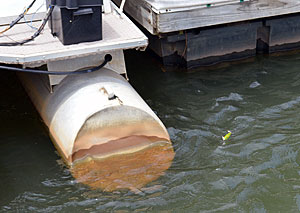
Watch for small buoys when you are moving between docks. They often indicate the end of a homeowner’s water intake or, more often, in Northern waters, a deeper mooring spot for larger vessels. Either one will be anchored with something heavy such as several concrete blocks. Just like a single stump on a deep river channel ledge, these pieces of cover can hold big bass. You don’t need a different lure or even to slow down. One or two quick pitches will tell you if a bass lives there.
Swim platforms are worth fishing, too. They are more prevalent in Northern waters and, in essence, are floating docks moored away from shore. Fish them like a stationary dock, skipping your lures under them or running a topwater, crankbait, or spinnerbait down shady sides.
Swim platforms are usually anchored by a chain or rope attached directly underneath. That means there will be another piece of cover in the form of an anchor on the bottom. In lakes with grass, that rope or chain works like a sickle, helping the shade created by the platform to clear a spot in the weeds. Bass use those edges as ambush points. A similar thing happens with moored sailboats. As they shift with the wind, the rope and keel work together to clear an open spot in the grass. That’s a great place to catch smallmouth.
In many Northern lakes, docks are built on cribs, boxes made of logs, and filled with rock because they can withstand mighty springtime ice floes that push other types of docks onto the shore. Over time, docks may disappear, but their cribs remain underwater. They often reveal themselves as large, rectangular holes in the grass or dark spots in murkier water. Cast at them. The combination of rock, wood, and grass will draw bass.



